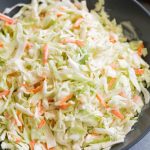 The need to change the peculiar into the familiar is powerful, as is demonstrated by the repeated attempts since the eighteenth century to turn cole slaw into cold slaw. The cole in coleslaw, however, has nothing to do with the word cold, even though this cabbage salad is indeed chilled before being served; instead, cole represents the Dutch too/, meaning cabbage, while the slaw is an English respelling of sla, a Dutch abbreviation of salade. Although cole may now seem like a peculiar word, it was once commonplace, that is, until cabbage appeared in English in the fifteenth century and gradually replaced it. In Scotland the word has persisted as kale, the name of a cabbage whose leaves curl outward like ears instead of inward to form a head. Kale was once such an important part of the Scottish diet that gardens were called kale-yards and dinner was sometimes called kale-time. The word cole, or rather its German cousin, also exists in kohlrabi, meaning cabbage-turnip, yet another variety of cabbage.
The need to change the peculiar into the familiar is powerful, as is demonstrated by the repeated attempts since the eighteenth century to turn cole slaw into cold slaw. The cole in coleslaw, however, has nothing to do with the word cold, even though this cabbage salad is indeed chilled before being served; instead, cole represents the Dutch too/, meaning cabbage, while the slaw is an English respelling of sla, a Dutch abbreviation of salade. Although cole may now seem like a peculiar word, it was once commonplace, that is, until cabbage appeared in English in the fifteenth century and gradually replaced it. In Scotland the word has persisted as kale, the name of a cabbage whose leaves curl outward like ears instead of inward to form a head. Kale was once such an important part of the Scottish diet that gardens were called kale-yards and dinner was sometimes called kale-time. The word cole, or rather its German cousin, also exists in kohlrabi, meaning cabbage-turnip, yet another variety of cabbage.
A dish consisting of finely sliced cabbage mixed with a savory sauce; it goes by the moniker that originates from the Dutch terms for shredded cabbage and vegetable dish.
A salad comprising of a foundation of finely shredded raw white cabbage, is commonly paired with a dressing of cream or mayonnaise. This salad, referred to as coleslaw, is incredibly versatile in terms of its additional ingredients. It can include grated carrot, chopped apple, chopped onion, nuts, dried fruit, cooked corn, chopped celery, and chopped green pepper, among others. Coleslaw may be served in a traditional bowl or in a hollowed-out cabbage. It is a staple side dish that pairs well with a variety of dishes such as hamburgers, fish dishes, and cold meats.
